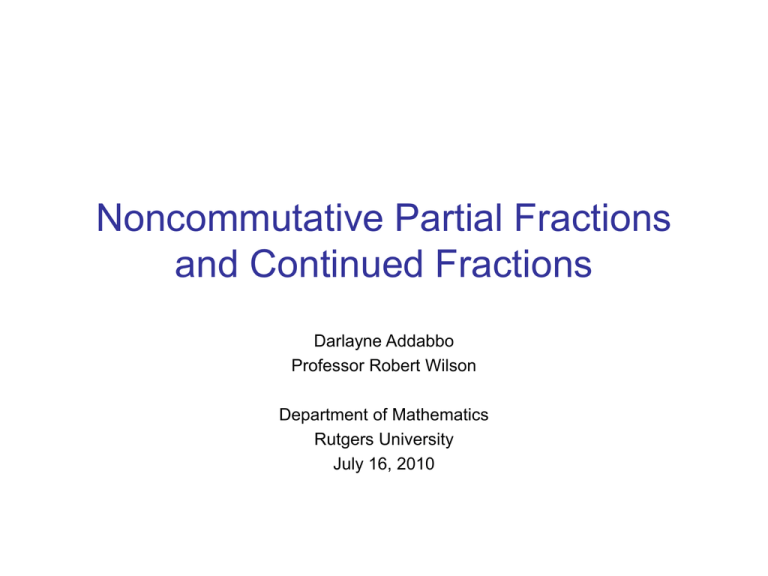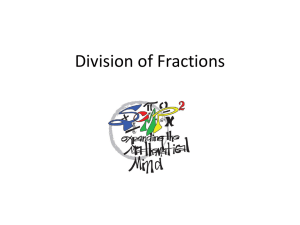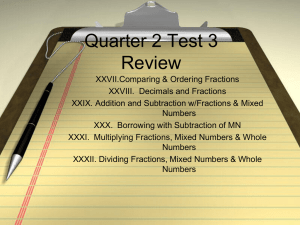
Noncommutative Partial Fractions
and Continued Fractions
Darlayne Addabbo
Professor Robert Wilson
Department of Mathematics
Rutgers University
July 16, 2010
Overview
1) Existence of partial fraction
decompositions over division rings
2) Relation between Laurent series and
quasideterminants
3) Generalization of Galois’s result that
every periodic continued fraction
satisfies a quadratic equation
Partial Fractions in C
(complex numbers)
• If f(x) is a polynomial over C of degree n
with distinct roots 1,..., n , then
1
A1
An
...
f (x) x 1
x n
for someA1,...,An in C.
Example
1
1
1
2
2
2
x 1 x 1 x 1
We may also write
1
A1
An
...
f (x) x 1
x n
( f (x)) (x 1) A1 ... (x n ) An
1
1
1
as
The two expressions are the same over
Ai
C. However, over a division ring, x
i
is ambiguous. (It could be equal to
1
1
(x i ) Ai or Ai (x i ) .)
To avoid ambiguity, we prefer the
second notation.
Can we generalize the method of
partial fractions to an arbitrary
division ring, D?
• Recall that a division ring satisfies all of the axioms of
a field except that multiplication is not required to be
commutative.
• Over a field, if f(x) is a monic polynomial of degree n,
with n distinct roots 1,...,n , f (x) (x 1 )...(x n )
• But this doesn’t work in a division ring. It doesn’t even
work in the quaternions.
(Recall) The Algebra of
Quaternions
• The algebra of quaternions is a four
dimensional vector space over R (the
real numbers), with basis 1, i, j, k and
multiplication satisfying:
• ij=-ji=k
• jk=-kj=i
• ki=-ik=j
• 1 is the multiplicative identity
An example
f (x) x (2 j)x (2 j k)
2
has roots i+1 and 1+i+j
Check:
(i 1) 2 (2 j)(i 1) 2 j k
1 2i 1 2i k 2 j 2 j k
0
Similarly,
(1 i j)2 (2 j)(1 i j) 2 j k 0.
But f (x) (x (1 i j))( x (1 i))
Instead,
f (x) (x (1 i j))( x (1 i)) (x (1 i))( x (1 i j))
Note that each root corresponds to the
rightmost factor of one of these expressions.
(This is due to a result of Ore.)
Using the above to solve partial
fractions
(x 2 (2 j)x (2 j k))1 (x (1 i))1 A1 (x (1 i j))1 A2
x 2 (2 j)x (2 j k) (x y)(x (1 i))
(x z)(x (1 i j))
where y, z are elements of the
quaternions
So 1 (x y)A1 (x z)A2 which gives
A1 A2 0
and (since we can write y and z in terms of
1+i and 1+i+j),
(1 i)A1 (1 i j)A2 1
Thus
1
1
1 i 1 i
A1 0
jA2 1
So we have generalized the method of partial
fractions.
Theorem
Let
f (x) x n B1 x n1 ... Bn ,
with
B1,...,Bn D, have distinct roots,
1,...,n D .
Then there exist elements, A1,...,An D
such that
( f (x)) (x 1) A1 ... (x n ) An
1
1
1
1) First prove inductively that
(x y n )( x y n1)...(x y1)
n
x n (1)( y i )x n1 (1)2 ( y j1 y j0 )x n2 ... (1)n y n y n1...y1
i1
j1 j0
2) By the Gelfand-Retakh Vieta Theorem,
we can write
f (x) x n B1x n1 B2 x n2 ... Bn
(x a1,1)( x a1,2 )...(x a1,n )
(x a2,1)( x a2,2 )...(x a2,n )
...
(x an,1)( x an,2 )...(x an,n )
where each ai, j ,1 i n,1 j n, is an element
of our division ring, D, and ai,n i for all
i,1 i n
3) Obtaining our set of equations
Recall that we want to find Ai s such that
(x 1)1 A1 (x 2 )1 A2 ... (x n )1 An
(x B1x
n
n1
B2 x
n2
1
... Bn )
We multiply both sides of our equation
1
by f(x). Notice that our (x i ) terms
cancel.
4) Obtaining our System of Equations
Comparing terms on both sides of our
equation, we obtain
1
1
1
2
3
1
12
2 2
3 2
n1
2 n1 3 n1
1
1 A1 0
... n A2 0
2
... n A3 0
n1
... n
An
1
...
Using the Generalized Cramer’s Rule,
we can solve this system of equations .
Continued Fractions
In the commutative case, periodic continued
fractions are often written as follows
a0
1
a1
1
a2
a0 ,a1,...,an F, a field.
1
...an
1
Continued Fractions
In the noncommutative case, we avoid
ambiguity by writing our continued
fractions using nested parentheses.
a0 (a1 (... (an ) ...)
1 1
1
where a0 ,a1,...,an D, a division ring
There is a theorem by Galois which says that every
periodic continued fraction is a solution to a quadratic
equation. I generalized this to show that a periodic
continued fraction over a division ring, D, satisfies
xAx Bx xC E 0
where A,B,C,E D
We can write A,B,C,E in terms of a1,a2 ,...,an, the
repeating terms of our continued fraction
Current Work
Galois showed that there is a
relationship between the complex
conjugate of a periodic continued
fraction and the periodic continued
fraction obtained when we write the
repeating terms in reverse order. We
want to generalize this to the noncommutative case.
References
Gelʹfand, I. M.; Retakh, V. S. Theory of noncommutative determinants, and
characteristic functions of graphs. (Russian) Funktsional. Anal. i
Prilozhen. 26 (1992), no. 4, 1--20, 96; translation in Funct. Anal. Appl.
26 (1992), no. 4, 231--246 (1993)
Holtz, Olga, and Mikhail Tyaglov. "Structured Matrices, Continued
Fractions, and Root Localization of Polynomials.”
http://www.cs.berkeley.edu/~oholtz/RF.pdf
Lauritzen, Neils. "Continued Fractions and Factoring.”
http://www.dm.unito.it/~cerruti/ac/cfracfact.pdf
Wilson, Robert L. "Three Lectures on Quasideterminants." Lecture.
http://www.mat.ufg.br/bienal/2006/mini/wilson.pdf









